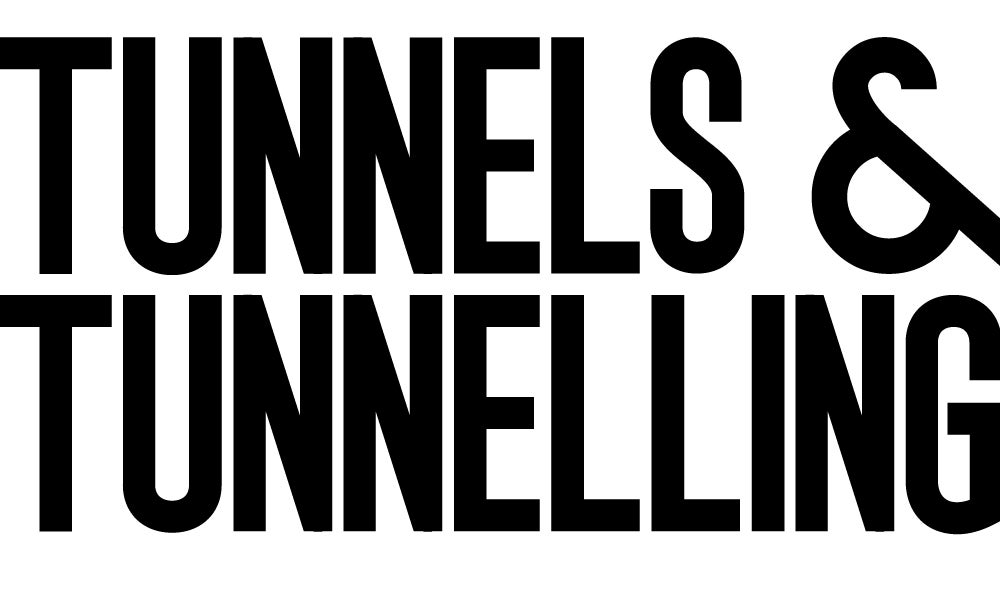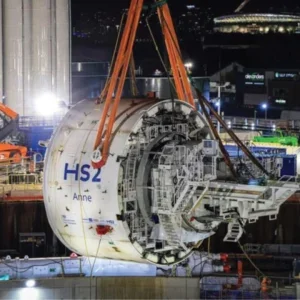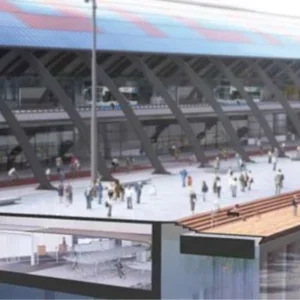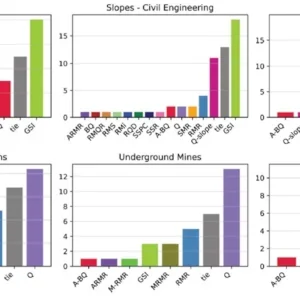Disruption due to severe winter weather has long been a problem for motorists wishing to make the 450km journey on the E16 from Bergen to the Norwegian capital, Oslo. Even in good weather, the winding roads, fjords and mountain crossings of this spectacular part of western Norway make travelling from A to B less than straightforward.
Over the past 20 years, it has been government policy to improve infrastructure links across the country to shorten journey times, reduce ferry links and make travelling safer and more reliable, even in the depths of winter. As a result of this policy, together with a desire to avoid rockfalls in difficult terrain and minimise environmental impact, many tunnel links have been constructed. In fact, during the past two decades, the Norwegian Public Roads Administration has built around 100km of road tunnels in the Sogn og Fjordane region alone.
Among the main highways in this region, the E16 between Oslo and Bergen (Norway’s two largest cities) is a perfect candidate for such underground solutions, and has already seen construction of the 11.4km long Gudvanga Tunnel, which opened in 1992. Now construction is under way on what will be the world’s longest road tunnel, the 24.5km long Laerdal Tunnel. This $130m monster runs north-south between the towns of Aurland and Laerdal and eclipses the previous record holder, the 16.9km St Gotthard road tunnel in Switzerland.
However, despite the immensity of the undertaking, the level of usage is expected to be low, with a design capacity of just 400 vehicles/h, or an average of 1000/day.
In addition to the main drive, with its 60 sq m cross section, the project features a 2.1km intermediate access and ventilation tunnel, 18km from the Aurland portal; 16 turning points; 48 emergency lay-bys; and three 30m x 40m caverns, which are designed to be large enough to permit coaches and trucks to turn round in an emergency without reversing. These turning areas will also be decorated and lit with a view to relieving the tedium of the 20 minute journey time.
The tunnel rises from Aurland at a gradient of 2.1% to a high point at 265m above sea level, from which it falls at 0.7% to the location of the access adit, falling from there to Laerdal at 2.7%. Mindful of the need for safety, the two-lane highway features straights and gentle curves to alleviate boredom. Light will be provided every 18m, telephones installed every 250m and fire equipment every 125m. In addition, 12 video cameras will be sited throughout the tunnel length, linked to a 24h control centre, and radio aerials will provide radio reception throughout and will allow the use of mobile telephones. There will be a separate channel for police, fireman and ambulance.
The tunnel is being driven through hard Precambrian gneiss of 70-120MPa, which provides generally good tunnelling conditions. However, the overburden, which reaches a maximum of 1400m and is over 800m for 20km of the tunnel length, leads to high vertical stress and the danger of rockbursting. The horizontal stress is also high, originating in movements in the Earth’s crust.
Excavation is performed by drill+blast, and around 2.5million cu m of spoil will be produced. Some of this spoil will be used on improvements to the E16, some will be used to build footpaths around the nearby fjords, and the remainder will be used for landscaping around the portal of the intermediate access tunnel.
Work on the project began in March 1995, when the project was let in two packages. The Norwegian Public Roads Administration, acting as contractor, is driving the 11km section from Aurland in the south (itself claimed as a record for a single drive with no intermediate access) plus the northern portal and the first 500m of tunnel outside Laerdal.
Eeg-Henriksen, the Norwegian subsidiary of NCC, is responsible for the 2.1km intermediate access tunnel at Tynjadal, which descends at an11.1% gradient to provide access to the main tunnel, where the contractor is excavating the 6km drive north towards Laerdal and the 7km section south towards Aurland. Here it will hole through into the Norwegian Public Roads Administration’s contract. The access tunnel will be used for ventilation when the tunnel is in operation.
T&T International visited Eeg-Henriksen’s contract during the final stages of main excavation earlier this year. Excavation was carried out by drill+blast, which was undertaken on a maximum of two faces during the works using two x 3-boom computerised drilling jumbos from Andersens Mek Verksted of Norway. These units feature Montabert drills and a computer controlled drill system from Bever Control, which is also used by Atlas Copco.
To achieve the theoretical cross section target of 56.7 sq m, these jumbos were drilling approximately 100 holes/round at a rate of 1.5-2m/min. It took 21¼2.hours to drill the round and 30 minutes to pack with explosive. Initially, these holes were 6.1m deep but this was reduced to 5.5m by the contractor in the interests of increased productivity. In another development, 500kg of explosive/round, or 2.3kg/cu m excavated, was recorded, which is around 15% higher than expected and thought to be due to the material encountered. In total, excavation during the contract entailed the placing of 5000 rounds.
According to the site staff, two to three rounds/day/face were achieved by crews working two shifts, 24h/day. Crews worked 12 days on, 9 days off, with bonus payments linked to productivity.
Throughout this immense undertaking, accuracy has been all important. An accuracy of +/-150mm was achieved thanks to a satellite navigation and laser guidance system. The contractor reported that overbreak had been minimised to around 10% because the crew was following a computer based system for drilling, provided by Bever Control. All mud and drilling water produced on the project must be purified before being pumped out of the tunnel.
The intermediate access adit, 65 sq m in cross section, took one year to excavate, during which time the contractor had to contend with areas of poor rock quality and rock bursting. However, once the main drive started, an average advance rate of around 5m/round was achieved, says Eeg-Henriksen, with a total of up to 50m/day from three faces, or 130-170m/week. The highest productivity claimed for any one face is 110m/week.
Following blasting, an Atlas 1504 wheeled excavator fitted with a Rammer hydraulic hammer was used to clean the face and remove loose material. Then, muck was removed by a fleet of 70 tonne semi-articulated trucks from Mercedes and Volvo, which were loaded by 50t Volvo L330C low emission wheeled loaders, fitted with special 6.5 cu m side tipping buckets from Gjerstadt of Norway.
The use of large-scale plant on the project is one of the unusual aspects of the solution adopted by Eeg-Henriksen. The contractor maintains that it permitted high productivity despite the cramped working conditions experienced when a truck and a wheeled loader occupied the same length of tunnel at the face.
The contractor considered belt conveyors at the planning stage but they were thought to be too expensive because of the lengths involved and the in-tunnel crushing requirements this solution would have necessitated.
With a theoretical breakout of 300cu m per round, it took an average 80 minutes to clear the face. At the peak of operations, three wheeled loaders and a fleet of seven trucks was employed on the contract, with the nearest turning caverns used as temporary dumping sites when it proved necessary to keep up with blasting operations. The choice of the powerful 500hp trucks was determined by the tight turning circle within the tunnel – which was achieved with millimetres to spare by the skilled drivers – and the steep 11% incline of the access tunnel. The special trailer bodies fitted were made by Norwegian manufacturer Nor Slep.
Because of the distances involved, ventilation was a major concern, both during construction and in the design of the tunnel operating systems. Indeed, fewer heavy vehicles will use the finished tunnel than were present during construction.
During construction, each of the two faces being driven from the access tunnel were supplied with air by a Korfmann AL17 fan with two 270kW motors in two separate ducts supplied by Protan. These four fans were mounted outside the portal of the access tunnel. However, to speed up the removal of blasting fumes, an additional GAL14 119kW fan was mounted 200m behind each face to extract air from the tunnel via one of the ducts approximately 50 minutes after each blast, while fresh air was still coming in through the other duct. The ducts were connected with gussets so air could be transported both in and out.
This complex fan system was monitored and controlled from a centre set up at the Laerdal portal. It uses high-tech communications and computerised control systems. Adjustments to the operation of the ventilation system could also be made by workers at the face using control boxed installed in the tunnel. According to the contractor, this system, which has remote and central control, was the first of its kind in the world, but its contribution to the efficiency and speed of the drill+blast operation more than compensated for the investment involved.
It has been estimated that, in operation, each car will require 1800 cu m of fresh air on the run through the tunnel. Fresh air will be drawn in from the Aurland portal by roof mounted impulse fans, with fumes removed via the access tunnel at Tynjadal. To reduce the volumes of air required and keep energy costs down, an air treatment plant has been installed 18km from the Aurland portal. Here, dust and NO2 gas are scrubbed in a facility thought to be unique to Laerdal, before being re-introduced into the tunnel. The 100m long NO2 filter can process air at the 2m/s speed that it is extracted from the tunnel, handling around 120cu m/s.
Following drill+blast operations, the tunnel was allowed to advance 10-15m before wet shotcrete with a steel fibre content of 40kg/cu m was applied at a rate of about 1.8 cu m/metre advanced. This was applied in a 50-100mm thick layer. The contractor estimates that around 27 000 cu m of shotcrete will be used – about 33% more than stated in the contract papers, mainly because of the rock encountered. Rock support was further enhanced by installing around 25 galvanised steel rockbolts/round, each 2.5-4m long. These were installed at the same time as blast drilling and were resin anchored in place; 96 000 will be installed altogether on the contract.
Stress measurements taken in 1996 showed vertical readings of 25MPa and horizontal forces of 31.6MPa. In the worst case encountered in practice, horizontal stresses three times the vertical pressure have been measured. Because of the danger of spalling this indicated, 25mm diameter, 6m long spalling bolts were specified for susceptible areas.
No secondary lining is being provided except for short lengths at either portal, and the tunnel is generally very dry, with little in the way of waterproofing required. Only 15 000 sq m of polyethylene foam membrane, from Termonova, is being installed along a 13.5km length, and this is being shotcreted over for fire safety reasons.
In the final stage of construction, the road is being built 1.5-2km behind the face, with asphalt laid twice a year so as not to interfere with the blasting schedule.
Work on the project started in 1995 and the northern drive to the Laerdal portal broke through in February 1999. When T&T International visited the site, excavation was almost complete. NCC stopped tunnelling on June 9 and breakthrough was expected in August. However, on June 14, the tunnel face at the Aurland site collapsed (World News, p10). Breakthrough is now due in September, still ahead of schedule.
Opening of the Laerdal Tunnel is scheduled for 2001, and Eeg-Henriksen is convinced that it will not only hold the record as the world’s longest road tunnel but may also go down in history as one of the cheapest per metre to build. The contractor estimates that excavation of the contract’s 15km of tunnel cost just $45m. This, together with the project’s good safety record, leads senior site engineers to believe that the decision to invest in large-scale mucking out plant and a sophisticated ventilation system was correct, and that this model could be used on other long tunnels in Norway.
Related Files
Location Map
Geological Section
Location of Laerdral Tunnel






